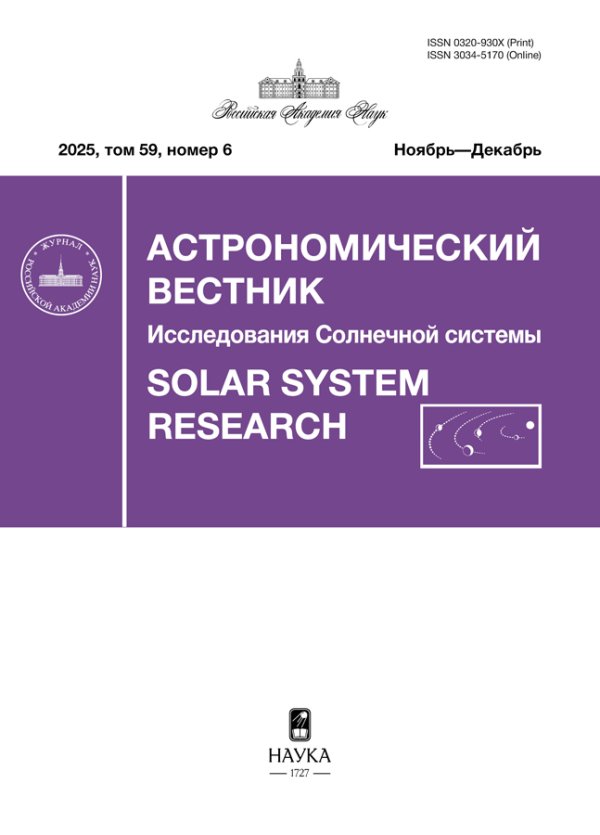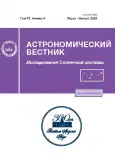Native Nickel–Iron Metals from Lonar Crater Impactites (India) and Regolith of the Moon
- Authors: Gornostaeva T.A.1, Kartashov P.M.1, Mokhov A.V.1, Rybchuk A.P.1, Basilevsky A.T.1
-
Affiliations:
- Vernadsky Institute of Geochemistry and Analytical Chemistry, Russian Academy of Sciences, Moscow, Russia
- Issue: Vol 57, No 4 (2023)
- Pages: 295-306
- Section: Articles
- URL: https://journals.rcsi.science/0320-930X/article/view/134977
- DOI: https://doi.org/10.31857/S0320930X23040035
- EDN: https://elibrary.ru/RDZGEA
- ID: 134977
Cite item
Full Text
Abstract
The Lonar crater (India) is the best preserved and most studied on Earth, formed in basalts, which makes it possible to conduct a comparative study with impact transformations of mineral matter on the Moon and other planets of the Solar System. Comparative studies have shown that impactor material, both on the Earth and on the Moon, is present in impactites not only in a geochemically dispersed form, as previously thought, but also in the form of individual submicron particles distributed in the molten target material. These are particles of native nickel, taenite, and high-nickel kamacite, which, apparently, are the transformed material of the impactor. High-nickel submicron metal inclusions are widespread in the impactites of the Lonar crater, as they were found in all studied preparations made from materials collected from different points along the rim of the crater. The high-nickel particles found in this study are an additional argument in favor of the previously stated assumption about the chondrite type of impactor.
Keywords
About the authors
T. A. Gornostaeva
Vernadsky Institute of Geochemistry and Analytical Chemistry, Russian Academy of Sciences, Moscow, Russia
Email: astvest@pleiadesonline.com
Россия, Москва
P. M. Kartashov
Vernadsky Institute of Geochemistry and Analytical Chemistry, Russian Academy of Sciences, Moscow, Russia
Email: astvest@pleiadesonline.com
Россия, Москва
A. V. Mokhov
Vernadsky Institute of Geochemistry and Analytical Chemistry, Russian Academy of Sciences, Moscow, Russia
Email: astvest@pleiadesonline.com
Россия, Москва
A. P. Rybchuk
Vernadsky Institute of Geochemistry and Analytical Chemistry, Russian Academy of Sciences, Moscow, Russia
Email: astvest@pleiadesonline.com
Россия, Москва
A. T. Basilevsky
Vernadsky Institute of Geochemistry and Analytical Chemistry, Russian Academy of Sciences, Moscow, Russia
Author for correspondence.
Email: atbas@geokhi.ru
Россия, Москва
References
- Базилевский А.Т., Назаров М.А. Отчет о результатах командирования ученых за границу; страна командирования Индия. ГЕОХИ АН СССР, 1983. 16 с.
- Главатских С.Ф., Трубкин Н.В. Самородный теллур и никель из высокотемпературных газовых возгонов Большого Трещинного Толбачинского Извержения (Камчатка) // ДАН. 2003. Т. 389. № 2. С. 231–234.
- Горностаева Т.А., Мохов А.В., Карташов П.М., Богатиков О.А. Космогенное вещество в кратере Жаманшин // ДАН. 2018. Т. 478. № 4. С. 447–451.
- Гриценко Ю., Полушкина С. Проявление самородного железа на реке Маймеча, Красноярский край, Россия // Х международный симпозиум “Минеральное разнообразие, исследование и сохранение”. София: Национальный музей “Земля и люди”, 2020. С. 201–206.
- Карташов П.М., Мохов А.В., Горностаева Т.А., Богатиков О.А., Ашихмина Н.А. Минеральные фазы на сколах стеклянных частиц в препарате тонкодисперсной фракции из пробы реголита АС “Луна‑24” // Петрология. 2010. Т. 18. № 2. С. 115–133.
- Макеев А.Б., Кисель С.И., Соболев В.К., Филиппов В.Н., Брянчанинова В.И. Самородные металлы в ореолах кимберлитовых трубок Архангельской алмазоносной провинции // ДАН. 2002. Т. 385. № 5. С. 677–681.
- Новгородова М.И. Кристаллохимия самородных металлов и природных интерметаллических соединений // Итоги науки и техники. Серия кристаллохимия. 1994. Т. 29. 153 с.
- Печерский Д.М., Марков Г.П., Цельмович В.А. Сравнение магнитных минералов в метеоритах и осадках // Двенадцатая Международная конференция “Физико-химические и петрофизические исследования в науках о Земле”. Москва–Борок 3–6 октября 2011 г. Материалы конференции. Москва, 2011. С. 278–281.
- Салтыковский А.Я., Цельмович В.А., Байараа Т., Никитин А.Н., Иванкина Т.И., Коматсу Дж., Ормоо Ю. Импактный кратер и состав космического вещества в раннепалеозойской структурной зоне Южной Монголии // Двенадцатая Международная конференция “Физико-химические и петрофизические исследования в науках о Земле”. Москва–Борок 3–6 октября 2011 г. Материалы конференции. Москва, 2011. С. 298–302.
- Яковлев О.И., Диков Ю.П., Герасимов М.В., Влотска Ф., Хут Й. Экспериментальное изучение факторов, определяющих состав стекол лунного реголита // Геохимия. 2003. № 5. С. 467–481.
- Artemieva N., Pierazzo E. The Canyon Diablo impact event: 2. Projectile fate and target melting upon impact // Meteoritics and Planet. Sci. 2011. V. 46. № 6. P. 805–829.
- Chao E.C.T., Dwornik E.J., Littler J. New data on the nickel-iron spherules from Southeast Asian tektites and their implications // Geochim. et Cosmochim. Acta. 1964. V. 28. № 6. P. 971–974.
- Crawford A.R. Mantle convection pattern under India: Relevance to Lonar crater, Girnar node and peri-Indian volcanism // J. Geol. Soc. India. 1983. V. 24. № 2. P. 97–100.
- D’Orazio M., Folco L., Zeoli A., Cordier C. Gebel Kamil: The iron meteorite that formed the Kamil crater (Egypt) // Meteoritics and Planet. Sci. 2011. V. 46. № 8. P. 1179–1196
- Ebert M., Hecht L., Deutsch A., Kenkmann T. Chemical modification of projectile residues and target material in a MEMIN cratering experiment // Meteoritics and Planet. Sci. 2013. V. 48. № 1. P. 134–149.
- Fredriksson K., Dube A., Milton D.J., Balasundara M.S. Lonar Lake, India: An impact crater in basalt // Science. 1973. V. 180. Iss. 4088. P. 862–864.
- French B.M. Traces of Catastrophe: A Handbook of Shock-Metamorphic Effects in Terrestrial Meteorite Impact Structures // LPI Contribution № 954. Houston: Lunar and Planetary Institute, 1998. 120 p.
- Frondel J.W. Lunar Mineralogy. New York: Wiley-Interscience, 1975. 332 p.
- Glass B.P., Fredriksson K., Florensky P.V. Microirghizites recovered from a sediment sample from the Zhamanchin impact structure // J. Geophys. Res.: Solid Earth. 1983. V. 88. Suppl. P. 319–330.
- Gore R., Mishra A., Deshmukh R. Exploring the mineralogy at Lonar crater with hyperspectral remote sensing // J. Geol. Soc. India. 2021. V. 97. P. 261–266.
- Jaret S.J., Phillips B.L., King D.T., Jr., Glotch T.D., Rahman Z., Wright S.P. An unusual occurrence of coesite at the Lonar crater, India // Meteoritics and Planet. Sci. 2017. V. 52. № 1. P. 147–163.
- Kearsley A., Graham G., McDonnell T. Bland P., Hough R., Helps P. Early fracturing and impact residue emplacement: Can modeling help to predict their location in major craters? // Meteoritics and Planet. Sci. 2004. V. 39. № 2. P. 247–265.
- Kleinmann B. Magnetite bearing spherules in tektites // Geochim. et Cosmochim. Acta. 1969. V. 33. № 9. P. 1113–1120.
- Lafond E.C., Dietz R.S. Lonar Crater, India, a meteorite crater? // Meteoritics. 1964. V. 2. № 2. P. 111–116.
- Maloof A.C., Stewart S.T., Weiss B.P., Soule S.A., Swanson-Hysell N.L., Louzada K.L., Garrick-Bethell I., Poussart P.M. Geology of Lonar crater, India // Geological Soc. of Am. Bull. 2010. V. 122. № 1/2. P. 109–126.
- Misra S., Newsom H.E., Shyam Prasad M., Geissman J.W., Dube A., Sengupta D. Geochemical evidence of the impactor for Lonar Crater, India: Solution to a century-old mystery // Meteoritics and Planet. Sci. 2009. V. 44. № 7. P. 1001–1018.
- Mittlefehldt D.W., See T.H., Hörz F. Dissemination and fractionation of projectile materials in the impact melts from Wabar crater, Saudi Arabia // Meteoritics. 1992. V. 27. № 4. P. 361–370.
- Mittlefehldt D.W., Hörz F., See T.H., Scott E.R., Mertzman S.A. Geochemistry of target rocks, impact-melt particles, and metallic spherules from Meteor Crater, Arizona: Empirical evidence on the impact process // Large meteorite impacts III. Boulder, CO: Geological Society of America, 2005. V. 384. P. 367–390.
- Mougel B., Moynier F., Koeberl C., Wielandt D., Bizzarro M. Identification of a meteoritic component using chromium isotopic composition of impact rocks from the Lonar impact structure, India // Meteoritics and Planet. Sci. 2019. V. 54. № 10. P. 2592–2599.
- Murali A.V., Zolensky M.E., Blanchard D.P. Tektite-like bodies at Lonar crater, India: Implications for the origin of tektites // J. Geophys. Res: Solid Earth. 1987. V. 92. № B4. P. E729–E735.
- Nayak V.K. Maskelynite from the Indian impact crater at Lonar // J. Geol. Soc. India. 1993. V. 41. № 4. P. 307–312.
- Nayak B., Meyer F.M. Tetrataenite in terrestrial rock // Am. Mineralogist. 2015. V. 100. № 1. P. 209–214.
- Osae S., Misra S., Koeberl C., Sengupta D., Ghosh S. Target rocks, impact glasses, and melt rocks from the Lonar impact crater, India: Petrography and geochemistry // Meteoritics and Planet. Sci. 2005. V. 40. № 9/10. P. 1473–1492.
- Pal P.C., Ramana C.V. Lonar lake – volcanic crater or astrobleme // CEG Bulletin. 1972. P. 114–121.
- Palme H., Grieve R.A.F., Wolf R. Identification of the projectile at the Brent crater, and further considerations of projectile types at terrestrial craters // Geochim. et Cosmochim. Acta 1981. V. 45. № 12. P. 2417–2424.
- Pechersky D.M., Markov G.P., Tsel’movich V.A. Pure iron and other magnetic minerals in meteorites // Sol. Syst. Res. 2015. V. 49. № 1. P. 61–71.
- Ray D., Upadhyay D., Misra S., Newsom H.E., Ghosh S. New insights on petrography and geochemistry of impactites from the Lonar crater, India // Meteoritics and Planet. Sci. 2017. V. 52. № 8. P. 1577–1599.
- Reid A.M., Park F.R., Cohen A.J. Synthetic metallic spherules in a Philippine tektite // Geochim. et Cosmochim. Acta. 1964. V. 28. № 6. P. 1004–1010.
- Schmieder M., Kring D.A. Earth’s impact events through geologic time: A list of recommended ages for terrestrial impact structures and deposits // Astrobiology. 2020. V. 20. № 1. P. 91–141.
- Schulz T., Luguet A., Wegner W., van Acken D., Koeberl C. Target rocks, impact glasses, and melt rocks from the Lonar crater, India: Highly siderophile element systematic and Sr–Nd–Os isotopic signatures // Meteoritics and Planet. Sci. 2016. V. 51. № 7. P. 1323–1339.
- Son T.H., Koeberl C. Chemical variation in Lonar impact glasses and impactites // GFF. 2007. V. 129. № 2. P. 161–176.
- Subrahmanyam B. Lonar crater, India: a crypto-volcanic origin // Geological Soc. India. 1985. V. 26. № 5. P. 326–335.
- Thorpe A.N., Senftle F.E. Submicroscopic spherules and color of tektites // Geochim. et Cosmochim. Acta. 1964. V. 28. № 6. P. 981–994.
- Trieman A.H., Lindstrom D.J., Schwandt C.S., Franchi I.A., Morgan M.L. A “mesosiderite” rock from northern Siberia, Russia: Not a meteorite // Meteoritics and Planet. Sci. 2002. V. 37. № S12. P. B13–B22.
- Welten K.C. Concentrations of siderophile elements in nonmagnetic fractions of Antarctic H- and L-chondrites: A quantitative approach on weathering effects // Meteoritics and Planet. Sci. 1999. V. 34. № 2. P. 259–270.
- Zanda B., Hewins R.H., Bourot-Denise M., Bland P.A. Albarède F. Formation of solar nebula reservoirs by mixing chondritic components // Earth and Planet. Sci. Lett. 2006. V. 248. № 3–4. P. 650–660.
Supplementary files





















